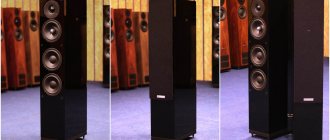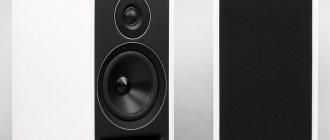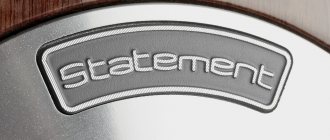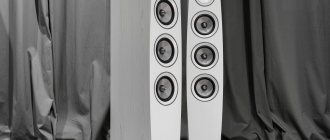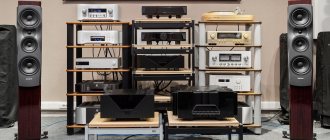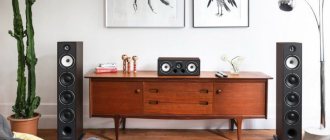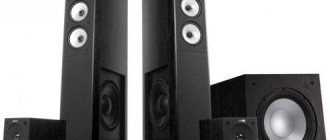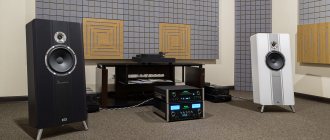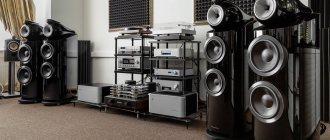Floor-standing speakers Legacy Audio V
American Legacy Audio has always surprised us with its ability to combine the fundamental principles of electroacoustics with the latest developments and materials. Floor-standing V systems, for example, use an open design that has been around for over 100 years and a state-of-the-art digital processor for band division and advanced room correction. Let's see what advantages in sound this variety of technical solutions provides.
To be honest, I haven’t followed Legacy Audio’s new products for a long time, and if I hadn’t known in advance what kind of systems I was going to listen to, I wouldn’t have immediately guessed the manufacturer of these futuristic designs. Older Legacy models have always looked a little old-fashioned, meeting the traditional ideas of wealthy Americans about interior luxury. Bill Duddleston, the company's founder and project manager, employs some of the finest cabinetmakers in the country, with invaluable experience dating back to the days when Legacy Audio's current factory produced church organs.
And now – a dynamic, somewhat technocratic design in the style of “Star Wars” (although it’s also an American classic!), with clear lines, a beveled front panel and an illuminated V in the center. However, continuity with earlier models, for example, Whisper XD, certainly takes place. And this, first of all, is the same freedom of engineering that distinguishes a bold research approach from the boring replication of standard solutions.
All five bass drivers are positioned in such a way that even at the lowest frequencies, the interaction of sound waves with the room is minimal.
The Model V we're going to listen to is a four-way model. The active bass section is built on a pair of 12-inch drivers with aluminum diffusers. The most interesting thing is that they voice different ranges and are connected to different built-in amplifiers. The lower woofer, together with a 1000-watt tip, is a powerful subwoofer operating from 16 Hz (!), and the second, with its own 500-watt amplification, expands the band to 400 Hz. The advanced B&O ICEpower Class D modules installed here are characterized by extremely low distortion. The rapidity of bass is ensured by three 10-inch passive radiators, one of which is directed towards the floor and creates tectonic effects. All five bass drivers are located in such a way that even at the lowest frequencies, the interaction of sound waves with the room is minimal, which eliminates hum, muttering and other troubles. And this is not the only option for room correction; I’ll tell you about a more effective one below.
The passive midrange consists of two huge 14-inch drivers with carbon fiber-reinforced cellulose cones and powerful neodymium magnets. They are installed in the upper part of the front shield and are covered at the back only with acoustically transparent fabric. The open design turns the mid-frequency tandem into a dipole driver with a free and detailed sound.
The third band, the upper middle, is sounded by two 6-inch heads, also operating in open space. This is an intermediate link; it is necessary to match large-caliber midrange drivers with supersonic 4-inch AMT tweeters, which Legacy Audio manufactures based on top-end Mundorf drivers. They are practically inertia-free, which guarantees ideal transmission of attack and the ability to reproduce frequencies up to 30 kHz without distortion. In Legacy Audio V, two such tweeters are installed at a slight angle to each other - to expand the stereo effect area.
In Legacy Audio V, two such tweeters are installed at a slight angle to each other - to expand the stereo effect area.
Each system weighs 105 kilograms; supports with dampers are used for decoupling from the floor. On the rear panel there are balanced inputs of the built-in amplifiers and two pairs of screw terminals for connecting speaker cables to the midrange and HF sections. There is also a network input and a power switch.
Cases are handcrafted in our factory in Springfield, Illinois. The selection of materials and build quality are beyond praise. The side planes are finished with natural veneer of seven types of wood at the customer’s choice and covered with several layers of piano varnish with each layer polished by hand. The side planes are finished with natural veneer of seven types of wood at the customer’s choice. Possible options include such exotics as African Mahogany. The construction also uses copper and carbon fiber, giving the impression of luxury in its modern form.
No matter how carefully the characteristics of all four bands are coordinated, the designer cannot know in advance in which room and with what amplification his acoustics will work. The flexibility to adapt the Legacy Audio V to a variety of environments is provided by the Wavelet external digital processor, which combines the functions of a DAC, 56-bit DSP and four-channel preamplifier with level controls and active frequency equalization. The software developed by Böhmer Audio provides for the study of the surrounding space using an external microphone and correction of the parameters of the reproducing path taking into account psychoacoustics. Wavelet can receive signals via analog and digital inputs, and supports PCM resolutions up to 24 bit/384 kHz via USB. The device is initially activated via the Internet, after which parameters can be changed via mobile devices or a computer. In the user manual, the description of this process takes 27 pages, so I will limit myself to only our specific case. Using Wavelet, it was possible to equalize the output of all drivers and obtain an ideal frequency response, set time delays in the channels for radiation coherence throughout the entire operating range, and eliminate standing waves in the room. The task was complicated by the fact that the volume of the room in which everything took place was too small for these giants, but the processor deserves even higher praise.
The software developed by Böhmer Audio provides for the study of the surrounding space using an external microphone and correction of the parameters of the reproducing path taking into account psychoacoustics.
Now a few words about the remaining components of the system. The Aqua La Diva CD transport and Aqua Formula DAC connected via an I2S bus are one of the best sources I have ever listened to. The band from 3 to 30 kHz was amplified by Alexander Tarim’s FloodHouse monoblocks, and the middle, from 400 to 3000 Hz, was amplified by Krell Solo 375 ends. The list of cables is given in the table.
The sound of the systems turned out to be flexible, with clearly drawn nuances and a holographic three-dimensional scene. What immediately attracted my attention was that the huge acoustic systems began to play dynamically and clearly, with a distinct lower register, i.e. as if they were surrounded by absolutely empty space, but how it really was, you can judge from the photo. I turn up the volume - no negative effects, the room seems to have no walls, no ceiling, no floor. The bass is collected, very accurate, without extraneous sounds, humming, etc. The distance from the sofa to the front line is small, but the four stripes sounded like one. When constructing a space, Legacy Audio V creates a real three-dimensional picture, although they themselves modestly remain on the sidelines - with such and such dimensions and in a small room. A sound stage with sharp fixation of virtual images and a foreground that spans the entire width of the room.
Huge acoustic systems played as if they were surrounded by absolutely empty space, but you can judge how it really was from the photo.
The Wavelet processor also deserves compliments: with the colossal work it performs, its digital path is not audible in the system at all. The upper band, voiced by the weightless tweeter emitters, is absolutely clean and transparent, with the characteristic “silver” of the Aqua source at the very top of the spectrum. High resolution does not seem exaggerated; a lot of details fit organically into the overall picture. Cymbals, overtones of wind instruments, a triangle in an orchestra - all this is conveyed impeccably. And a very correct middle. Lightweight 14-inch diffusers with complete freedom in open space provide a lot of musical information both in the vocal range and above, where most of the energy of strings and wind instruments is concentrated. The stripe is alive, natural, open. And this feeling is enhanced by deep, even tectonic effects, bass.
It is valuable that, given their dimensions, the Legacy Audio Vs do not try to impress solely with drive and deafening dynamics (although, where necessary, all this will be more than enough), they are extremely careful about the musical material that is offered to them. There are no genre boundaries for them, thanks to the fact that the developers took the best design solutions for each frequency band and linked them together using clever digital algorithms. The result is truly universal acoustics, capable of working even in rooms where another, similar size, would turn the sound into mush.
Lightweight 14-inch diffusers with complete freedom in open space provide a lot of musical information both in the vocal range and above, where most of the energy of strings and wind instruments is concentrated.
COMPONENTS
- CD transport Aqua La Diva
- Aqua Formula DAC
- Legacy Audio Wavelet Digital Crossover/Preamplifier
- Midrange amplifiers Krell Solo 375
- HF amplifiers Tarim Audio FloodHouse
- Network air conditioner Torus Power
- Cables: digital Aqua I2S AQlink
- interconnect Tributaries 8AB-015B XLR
- acoustic Gryphon VIP Reference (midrange), Clarus Aqua CAP-HC-S-060 (HF)
- network Tributaries 6PF-IEC-060B
MUSIC
- Dali, “In Admiration of Music. Volume 4". Dali CD, 2015
- Jean Sibelius "Violin Concerto". Anne-Sophie Mutter & Staatskapelle Dresden. Deutsche Grammophon, 1995
- Sweetbox. BMG/RCA, 1998
- Dream Theater, "Falling Into Infinity". EastWest Records, 1997.
Legacy Audio V
Manufacturer: Legacy Audio (USA)
https://legacyaudio.com
https://legacyaudio.ru
Configuration: 8 emitters, 4 bands || Acoustic low-frequency design: passive radiator, open || Frequency range: 16 - 30000 Hz (+/- 2 dB) || Nominal Resistance: 4 Ohms || Crossover frequencies: 80/400/3000 Hz || HF/MF section sensitivity: 98 dB (2.83 V, 1 m) || Power of the built-in amplifiers of the low-frequency section/subwoofer: 500/1000 W || Finishes: Black Pearl, Rosewood, Walnut Maple, Birds Eye Maple, Olive Ash Burl, African Lacquered Mahogany (Natural or Cabernet) || Dimensions: 1500 x 406 x 445 mm || Weight 1 piece: 103 kg || Price per pair (with Wavelet processor): 6,800,000 .
The editors thank the Moscow AudioTime salon for assistance in conducting the test
share
Tags: Legacy Audio V
An undeniable victory
Price – 6,853,000 rubles.
In 1983, Bill Duddleston founded Legacy Audio. Over the past 34 years, the company has managed to earn success both among audiophiles and in the professional field: Legacy acoustics have been used by Sony and Universal Music studios; Rick Rubin, Antonio Reid and Herb Powers, winners of multiple Grammy awards, have worked on Legacy speakers on albums by Johnny Cash, Sheryl Crow and the Red Hot Chili Peppers. Steve Hoffman used them to remaster tracks by Elvis Presley and Frank Sinatra. In the early 2000s, Legacy Audio released the extraordinary Helix system, and in 2014 it was time for a new upgrade. The company's lineup is now headed by Legacy Audio V - which we will now study.
The technological aspects used in the V model are very interesting. One of the most important is the use of an external Wavelet processor. It is a DAC, a pre-amplifier, a crossover (digital, with DSP and four processing channels), and a room corrector. Leveling out room resonances and integrating huge speakers into a regular living room has never been so easy - V work equally well in both prepared audiophile “dens” and in a banal living room; you can place them close to the wall, close to the window - the rest will be taken care of by Wavelet. A special Bohmer algorithm, using the included calibrated microphone, creates a filter system to divide the signal into bands and correct the influence of the room in a time window with an accuracy of 40 ms. The work is being carried out in the following areas: - the processor restores the separation of signals at low frequencies, which is masked by the real dimensions of the room (increases the perception of the physical dimensions of the hall); — processes the signal in such a way as to minimize those reflections from walls and other surfaces that negatively affect its original parameters; — eliminates resonances; — minimizes parasitic oscillations of the digital signal (an apodization filter is used for these purposes).
The DAC section of Wavelet allows soft upgrades. At the moment it works with 24/192 signals via SPDiF and USB, and 24/96 via optical. Internal processing is limited to Analog Devices DSP parameters of 56 bits and 96 kHz.
Leveling out room resonances and integrating huge speakers into a regular living room has never been so easy - V work equally well in both prepared audiophile “dens” and in a banal living room; you can place them close to the wall, close to the window - the rest will be taken care of by Wavelet.
The second most important point is the acoustic design of the speakers. There are two 4″ AMT tweeters for high frequencies. The mid-frequency section is designed according to the “open box” principle and is equipped with two 6″ and two 14″ (!) drivers (in a dipole configuration) made of carbon-paper composite. The bass is powered by two speakers - one aluminum 12″ in a closed housing and another of the same 12″, loaded on three 10″ passive radiators. The magnets of all drivers are neodymium. The bass section is reinforced by a built-in D-class system (IcePower) with a total power of 3,000 (1,000 + 500 for each speaker) W; to amplify the remaining bands, you will need two more stereo or four mono amplifiers (switched to a Wavelet processor) with a power of 30 W or more. The amplitude-frequency characteristic V is stated from 16 to 30,000 Hz, the height of the speakers is 1.85 m, the weight of each is 103 kg. Crossover frequencies are 80, 400 and 3,000 Hz. Resistance – 4 Ohms, sensitivity – 98 dB.
Being very familiar with the Legacy Audio Focus, Whisper and Helix speakers, I began listening to the V somewhat intrigued. Helix is still one of the best loudspeaker systems in the world - few can compare with them in terms of the scale of sound. It’s difficult to fool physics - the larger the usable area of the speakers, the “bigger” the sound and the more information given to the listener. In this case, V operates with an even larger number of drivers, a more advanced processor and a different design. Better? We'll find out now.
The acoustics seem to disappear - this effect is the strongest of all the speakers I have ever heard. Complex passages, female vocals, fortissimo - everything is presented without a shadow of tension, naturally. Naturally. So, I don’t want to evaluate the detail, the timbres - it all fades into the background, and the listener... just listens to the music and enjoys it.
Externally, the speakers seem monumental - but do not create a feeling of heaviness. The design is quite harmonious, it lacks stars from the sky, but also does not cause outrage - like many High End systems. The initial setup of Wavelet is not difficult, but it takes about an hour - we calibrate the speakers and the room (three steps in total) and launch the profile. The Krell Connect Media Player streamer was used as a source, a Krell Duo 175 was used to boost the HF, and the midrange was powered by a pair of Krell Solo 375.
The first impression of the sound of the Legacy Audio V is lightness. Yes, yes, that's it. The acoustics seem to disappear - this effect is the strongest of all the speakers I have ever heard. Complex passages, female vocals, fortissimo - everything is presented without a shadow of tension, naturally. Naturally. So, I don’t want to evaluate the detail, the timbres - it all fades into the background, and the listener... just listens to the music and enjoys it.
If we talk about formal features, then the speakers form a very deep and wide stage. It is sweeping and super detailed. There’s just a sea of information coming in – ordinary “columns” seem like a pale imitation of “acoustics” against the backdrop of our monsters. The arrangement of the instruments is not holographic - rather physical. Deep and fundamental bass (as always with Legacy) is now adjacent to outstanding mids. The operation of a 14″ midrange (and, in fact, midbass speakers) in combination with 6″ drivers, and even in a dipole configuration, causes shock – what kind of Christmas tree is this? But Wavelet stitches them together so elegantly that you are amazed. The very nature of the sound differs from conventional speakers in much the same way as sculpture differs from painting. Sound with a capital letter, images in real size!
“Money for Nothing” by Dire Straits hits the drums right in the chest, while the guitar parts are perfect, as are Knopfler’s vocals. “Warriors of the World” by Manowar plunges into the abyss of ancient rage, and “Fade to Black” by Metallica materializes in Hetfield’s own room. “Mona Lisa” by George Benson and “Sweet Lorriane” by Nat King Cole are, again, rather physical sensations. I don’t want to take the orchestra apart, I want to enjoy being at the concert. Switching to Norah Jones - again, sibilants? What other sibilants? The vocals are live. And finally, BSO, we stage the Ninth Symphonies of Dvorak, Mahler and Beethoven. This is where the Vs reveal themselves in all their glory, forming the standard “third row effect”. Unique density of sound images and phenomenal resolution. Not a hint of digital signal processing. Bravo.
Passport details:
Type – four-way speaker system with external digital crossover | Name – Legacy Audio V | Frequency response, Hz – 16 – 30,000 Hz (level ±2 dB) | Resistance, Ohm – 4 | Sensitivity, dB – 98 | Crossover frequencies, Hz – 80, 400 and 3,000 | Tweeters – 4″ | Midrange speakers – 2 x 6″, 2 x 14″ | Woofers – 2 x 12″ | Passive LF radiators – 3 x 10″ | Dimensions, cm (one column) – 185 x 40.6 x 44.5 | Weight, kg (one column) – 103
